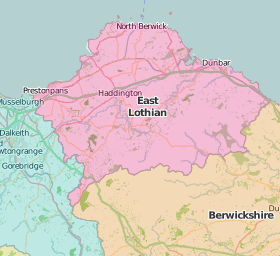
The winds of change have blown away Haddington (East Lothian) and Huntingdonshire (Cambridgeshire) but not Hertford, Hereford and Hampshire, where, according to Eliza Doolittle, “’urricanes ‘ardly hever ‘appen”.
In Haddington as elsewhere in Scotland the Commissioners of Supply carried out local government functions at county level until superseded by county councils in 1930. A collection of early 19th century pamphlets on farming matters suggests their postbox was busy: Robert Hunter’s Letter to the Commissioners of Supply for the County of Haddington (1804) on farm taxes generated a Review, Observations on the Review, and a Letter responding to the Observations on the Review (Haddington, 1805) by the agriculturalist Robert Brown (1747-1831).
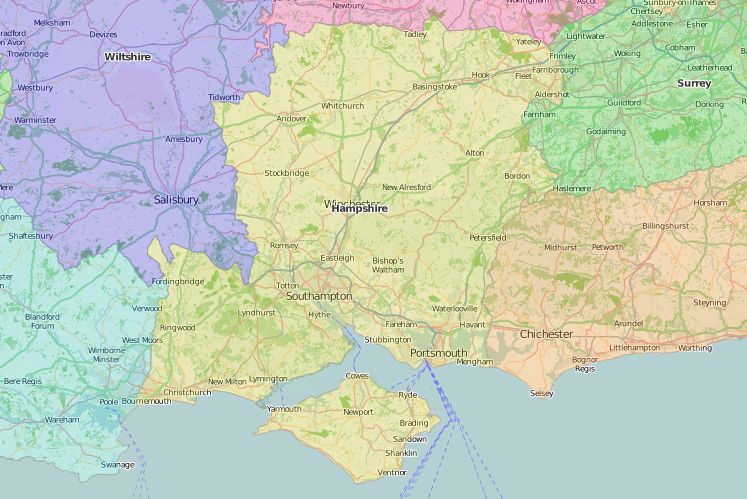
Speed’s map of Hampshire (Hantshire) has plenty of trees, depicting the “New Forrest”, with its free running deer, only one town plan (Winchester – Southampton has been displaced to the Isle of Wight map) but plenty of Earls, including Thomas Wriothesley, Earl of Southampton, whose house (formerly Titchfield Abbey) is, unusually, marked. Special Collections has both natural and civic histories of the county, with its plants detailed in William Gilpin’s Remarks on forest scenery … illustrated by the scenes of New-Forest in Hampshire (1791) and Frederick Townsend’s Flora (1879?).
The New Forest has been associated with Romany Gypsy families from the mid-seventeenth century: their 19th and 20th century acolytes in the Gypsy Lore Society included the artist Amelia Goddard and folk-song collector Alice Gillington, who lived in caravans near Thorney Hill. Some of the songs and dances from Gillington’s Songs of the open road were recreated at Thorney Hill in summer 2016. There are songs of a more satirical kind in the 1780 Collection of all the hand-bills, squibs, songs, essays, &c. published during the late contested election for the county of Hants. Portsmouth has its own History (1817), “with a particular description of the dock-yard, gun-wharf, Haslar Hospital, the towns of Portsea and Gosport, Portchester Castle, the Isle of Wight, and the most remarkable places in the vicinity.”
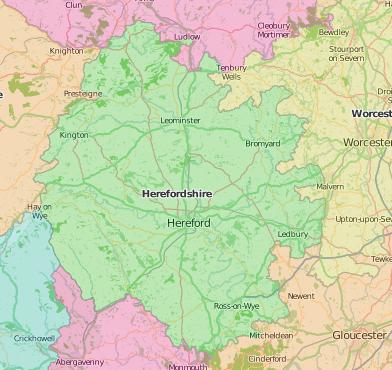
Speed’s Herefordshire is also covered in trees, but they are more likely to be orchards than forest. Advice is to hand on managing them in the prolific Richard Bradley’s New improvements of planting and gardening, both philosophical and practical. In three parts… To which is added, that scarce and valuable tract, intitled, Herefordshire-Orchards.
The sixth edition (1731) promises “an appendix, treating of several Matters omitted in the former Impressions”, although with a title already 115 words long, it is hard to see what might be missing. First published in 1717, Bradley’s work ran to a seventh edition in 1739. The publishing history of the tentatively titled Collections towards the history of the county of Hereford was quite the reverse: John Duncumb (1765-1839) settled in Hereford in 1788 as editor and printer of the Hereford Journal (1788-1790) and two years later was asked to edit a history of Herefordshire. A first volume (of three) appeared in 1804. Sir George Cornewall Lewis’s Glossary of provincial words used in Herefordshire and some adjoining counties appeared in the year of Duncumb’s death; it would no doubt have read quite differently by the time volume 2 was published in 1866, let alone the third, in 1882. Likewise, William Henry Purchas’s Flora of Herefordshire (1889), would have recorded much change in the 150 years since Richard Bradley was promoting, “The best Manner of Improving Flower Gardens or Parterres: Of Raising and Propagating all Sorts of Flowers”.
In this landlocked county, it is intriguing to find that Richard Hopton (1684-1764), a former resident of Canon Frome, owned Blanckley’s A naval expositor, shewing and explaining the words and terms of art belonging to the parts, qualities, and proportions of building, rigging, furnishing, & fitting a ship for sea. (1750).
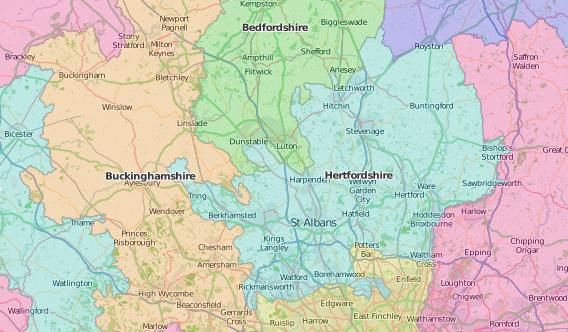
The 78-year genesis of Duncumb’s Hereford Collections makes the historian of Hertfordshire, Robert Clutterbuck, seem positively slapdash in taking a mere 18 years to compile The history and antiquities of the county of Hertford (1815-1827), although to be fair he also did some of the drawings. John Speed is complimentary about the county’s climate, “neither too hot nor too cold and with air temperate, sweet and healthful” and its economy, “destitute of nothing, that ministreth profit or pleasure of life” but his map is almost overshadowed by the three 15th century battles of the Wars of the Roses, at Barnet and St Albans, pictured and described in the margins, and even making an appearance in miniature on the map itself. The martyrdom of St Alban himself, “Brittaine’s Stephen” is also depicted on the picture of Verolanium, which looks a lot more like the early modern town than its Roman predecessor.
All this history makes lots of appearances in print: in addition to Clutterbuck, Special Collections holds the 1826 republication of Henry Chauncy’s county history (1700), John Edwin Cussan’s of 1870-1881, and the “botanical history” which introduces Alfred Reginald’s Flora (1887). Hertfordshire booklovers who have left their mark in the collections include the Elizabeth Westmore of Great Berkhamsted who wrote her name in the Souvenir for 1848, and several generations of the Gascoyne-Cecil family, Marquesses of Salisbury, since part of the family library at Hatfield House, was given to the University by the 5th Marquess, Robert Arthur James Gascoyne-Cecil (1893-1972), Chancellor of the University 1951-1971.
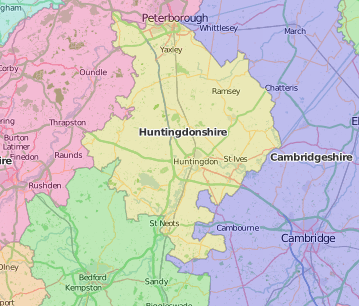
Speed’s map of Huntingdonshire carefully surveys the fens up to the Isle of Ely. The map’s legend has appropriately dressed huntsmen supporters with their dogs, hawk and fowling pieces ready for action.
There are more dogs out with their masters – and some peaceable cows – in the town plans of Huntingdon and Ely, which is included here as a natural adjunct to the Fens, rather than in its home county of Cambridgeshire. As well as the fens to the east, and the numerous windmills in the west, the map has the unusual distinction of including a road – the Great North Road – in addition to rivers and waterways. The draining of the Fens continued long after Speed’s time – there are 18th century drainage acts in Special Collections, and 20th century children’s books set in “the great East swamp”.
Huntingdonshire as a whole is in volume 7 (1808) of the monumental topographical work by John Britton (1771-1857) and Edward Wedlake Brayley (1773-1854): The beauties of England and Wales; or, Delineations, topographical, historical, and descriptive of each county. Britton’s great survey of English cathedrals did not include the Norman splendour of Ely, which James Bentham had masterfully described in The history and antiquities of the conventual & cathedral church of Ely (1771). The building dominates Speed’s town plan, but hides behind the dual legend of ‘Trinitie church’ and ‘S. Peter’s minster’.
Special Collections classmarks
Haddington
- Robert Brown (1747-1831), Letter to the author of the Observations on the review of Mr. Hunter’s letter to the Commissioners of Supply, for the County of Haddington (Haddington: Printed by Miller, 1805): SPEC Y80.3.28(4)
- Robert Hunter, Letter addressed to the Commissioners of Supply for the County of Haddington (1804): SPEC Y80.3.28(2)
Hampshire
- William Gilpin (1724-1804), Remarks on forest scenery … illustrated by the scenes of New-Forest in Hampshire (1791): SPEC Y79.3.552
- Frederick Townsend (1822-1905), Notes on the flora of Hampshire (1879): SPEC Ryl.Q.3.122/oversize
- Songs of the open road: Didakei ditties and Gypsy dances tunes and words collected in Hampshire by A.E. Gillington; music arranged and adapted by D. Sellars (1911): SPEC Scott Macfie B.4.24
- Alice E Gillington, Old Hampshire singing games and trilling the rope rhymes (19?): SPEC Scott Macfie A.7.50(1)
- Alice E. Gillington, Eight Hampshire folk-songs: taken from the mouths of the peasantry (19–?): SPEC Scott Macfie A.7.50(2)
- A collection of all the hand-bills, squibs, songs, essays, &c. published during the late contested election for the county of Hants between the Right Honourable Sir Richard Worsley, Bart. and Jervoise Clarke Jervoise, Esq., together with the poll of each division (Winchester : Printed and sold by John Wilkes, 1780): SPEC Thomson 13(12)
- Allen Lake, The history of Portsmouth; containing a full and enlarged account of its ancient and present state (London : Printed by Hatfield, and sold by S. Mills, Portsmouth; T. Whitewood, Portsea; W. Johnson, Gosport, 1817): SPEC Y81.3.214
Herefordshire
- Richard Bradley (1724), New improvements of planting and gardening, both philosophical and pratical. In three parts. I. Containing, a new system of vegetation. Explaining the Motion of the Sap, and Generation of Plants. Of Soils, and the Improvement of Forest-Trees. With a new Invention, whereby more Designs of Garden Plats may be made in an Hour, than can be found in all the Books of Gardening yet extant. II. The best Manner of Improving Flower Gardens or Parterres: Of Raising and Propagating all Sorts of Flowers; and of the Adorning of Gardens. III. Of Improving Fruit-Trees, Kitchen-Gardens, and Green-House Plants. With the Gentleman and Gardener’s Kalendar. To which is added, that scarce and valuable tract, intitled, Herefordshire-Orchards. The sixth edition, with an appendix, treating of several Matters omitted in the former Impressions. Illustrated with copper plates (1731): SPEC Y73.2.99
- John Duncumb (1765-1839), Collections towards the history of the county of Hereford (1804-1882): SPEC Y80.5.12
- Sir George Cornewall Lewis, Glossary of provincial words used in Herefordshire and some adjoining counties (1839): SPEC Y83.1.15
- William Henry Purchas (1823-1903), A flora of Herefordshire (Hereford, 1889): SPEC Y89.3.98.
- Thomas Riley Blanckley, A naval expositor (1750): SPEC L5.14
Hertfordshire
- Alfred Reginald Pryor (1839-1881), A flora of Hertfordshire Edited for the Hertfordshire Natural History Society by B.D. Jackson. With an introduction on the geology, climate, botanical history, etc. (1887): SPEC Y88.3.51
- John Edwin Cussans (1837-1899), History of Hertfordshire, containing an account of the descents of the various manors; pedigrees of families connected with the county; antiquities, local customs, &c. &c. (1870-1881): SPEC Q19.1/oversize
- Robert Clutterbuck (1772-1831), The history and antiquities of the county of Hertford compiled from the best printed authorities and original records, preserved in public repositories and private collections, embellished with views of the most curious monuments of antiquity, and illustrated with a map of the county (1815-1827): SPEC Q8.24/oversize
- Henry Chauncy, The historical antiquities of Hertfordshire: with the original of counties, hundreds or wapentakes, boroughs, corporations, towns, parishes, villages, and hamlets (1826): SPEC Y82.3.254.
- The Souvenir (1848): SPEC Annuals.1a.S725
Huntingdonshire
- William Dugdale, The history of imbanking and draining of divers fens and marshes, both in foreign parts and in this kingdom and of the improvements thereby (1772): SPEC H70.10
- Great Britain. Laws, statutes, etc. An act for draining, embanking, and preserving, certain fen lands and low grounds … in the parishes of Glatton and Holme, in the County of Huntingdon. [16 Geo. 3, cap. 64] (1776): SPEC Y77.5.110
- George Manville Fenn, Dick o’ the Fens: a tale of the great East swamp (1906): JUV A233.35
- John Britton, The beauties of England and Wales; or, Delineations, topographical, historical, and descriptive of each county (1801-1815): SPEC Y80.3.247-263 (Huntingdonshire is in volume 7: SPEC Y80.3.251)
- James Bentham, The history and antiquities of the conventual & cathedral church of Ely (1771): SPEC Y81.5.50